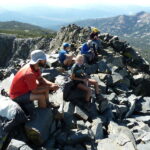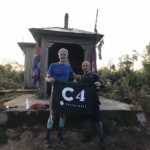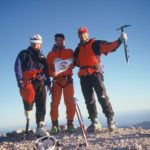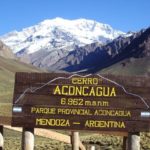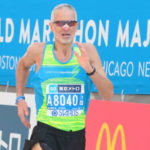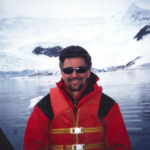

Trip Report #5 – Run to the Top of Europe
In March 1992, I heard about an event called, “Run to the Top of Europe”. The flyer said that the previous summer, a group of runners had made a multi-day running ascent of Mt. Elbrus in Russia. In the summer of 1992, a second such attempt would be made. The flyer went on to say that “With the new spirit of co-operation beyond the spirit of glasnost, getting to and around the USSR is now much more possible for determined athletes. Any American runners who think they can handle the challenge are invited to participate.” When I read that, I thought, “I’m always up for a challenge!” I had been wanting to climb Mt. Elbrus, because it’s the high point of Europe, and this seemed like a great way to accomplish that.
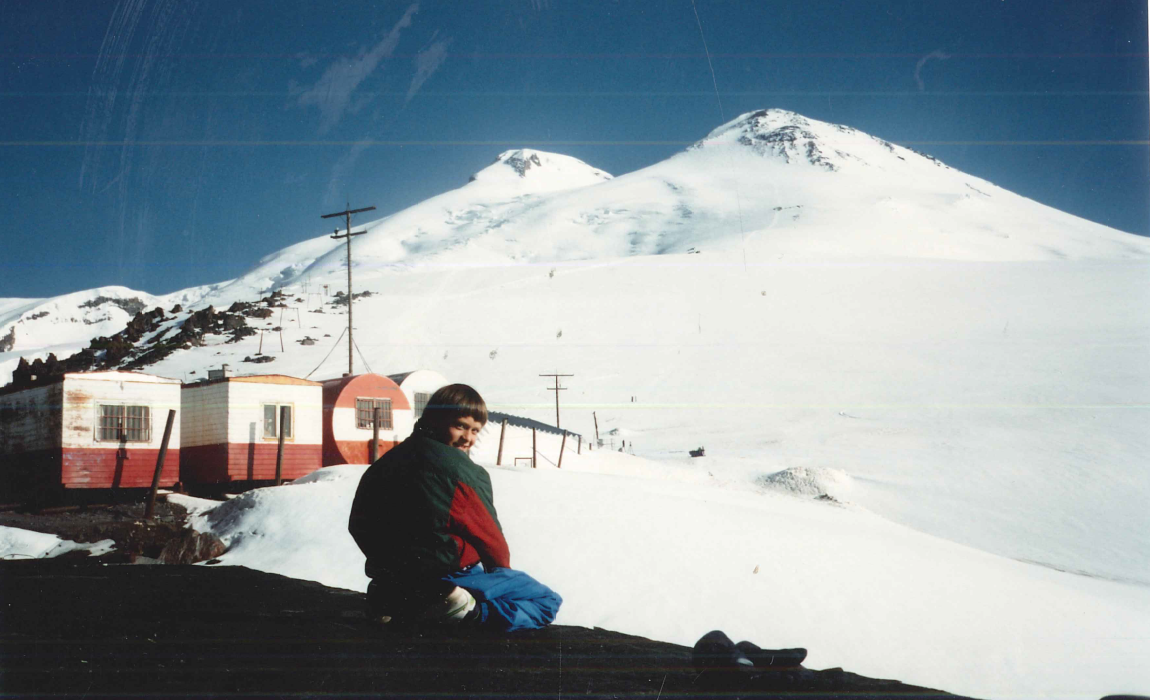
The race was organized as a four-day stage race. The first stage was from Tynaus (1350m) to Elbrus (1650m). It was 42 kilometers (marathon distance), completely on pavement. The second stage was from Elbrus to Azau (2350m). It was 23 kilometers, also on pavement. The third stage was from Azau to Priyut II (4100m). It was 15 kilometers on a dirt mountain road. The final stage was from Priyut II to the top of Mt. Elbrus (5642m). That stage was on snow the entire way. I thought that this event was right up my alley, because I was a climber and a distance/mountain runner. I signed up for the event, and was accepted. The race was scheduled to begin on July 31st.
On July 27th, 1992, I left Reno and flew to London. I arrived mid-day on the 28th and spent the day sightseeing. On the 29th, I flew to Moscow, arriving late in the day. When I arrived, the weather was grey. The Moscow airport was like nowhere I had ever been before. It was a little surreal, arriving there alone, not speaking any Russian, and unable to read any of the signage, as it was all in Cyrillic. After going through immigration and customs, it took a while for me to locate the two guys who were there to meet me. They spoke broken English and took me to a very small, very old car. It was all a little like something out of a movie, and I briefly thought I might never be seen again! These thoughts vanished quickly when we arrived at the offices of the Adventure Club/Sputnik, the organizers of the race. I met my interpreter, as well as the race director and other Sputnik members. A group of us had supper, and then I was taken to a very basic dormitory-style hotel where I spent the night.
The next morning, I was taken back to the Sputnik office, where all of the race participants (about 25 of us) had breakfast together. There were 2 Americans, 6-8 Europeans, and the rest were Russian. We took a bus to a small, regional airport, Bykovo. The 35-kilometer ride was interesting. My impressions were that everything was square, and in disrepair. There were a lot of checkpoints along the road, but most were abandoned. Those that were manned, we stopped at, without incident.
When we got to the airport, I was told not to speak, and to stay with the group. I followed directions, and we cleared security as a group and went to the gate. It was a one-of-a-kind flying experience. As a group, we walked into the bottom of the plane, carrying our luggage, and stowed it on giant luggage racks. Then we climbed steep metal stairs to the upper level of the plane, where the seats were. We were told to just take any open seat. The cabin was worn, and in disrepair. Take-off was also interesting. The whole cabin shook, overhead compartments opened, luggage fell out, and unoccupied seats folded forward. The drink and snack service was on mismatched plastic plates and cups of different colors and sizes, with 2 or 3 drink choices. Again, it was surreal, like a scene from a movie, and completely different from anything I had ever experienced. We made it, though, and arrived at our destination, Mineralnye Vody, around noon. We waited for over 1 hour for our bus. On the way to the lodge, we stopped for supper. We arrived in Terskol around 7.
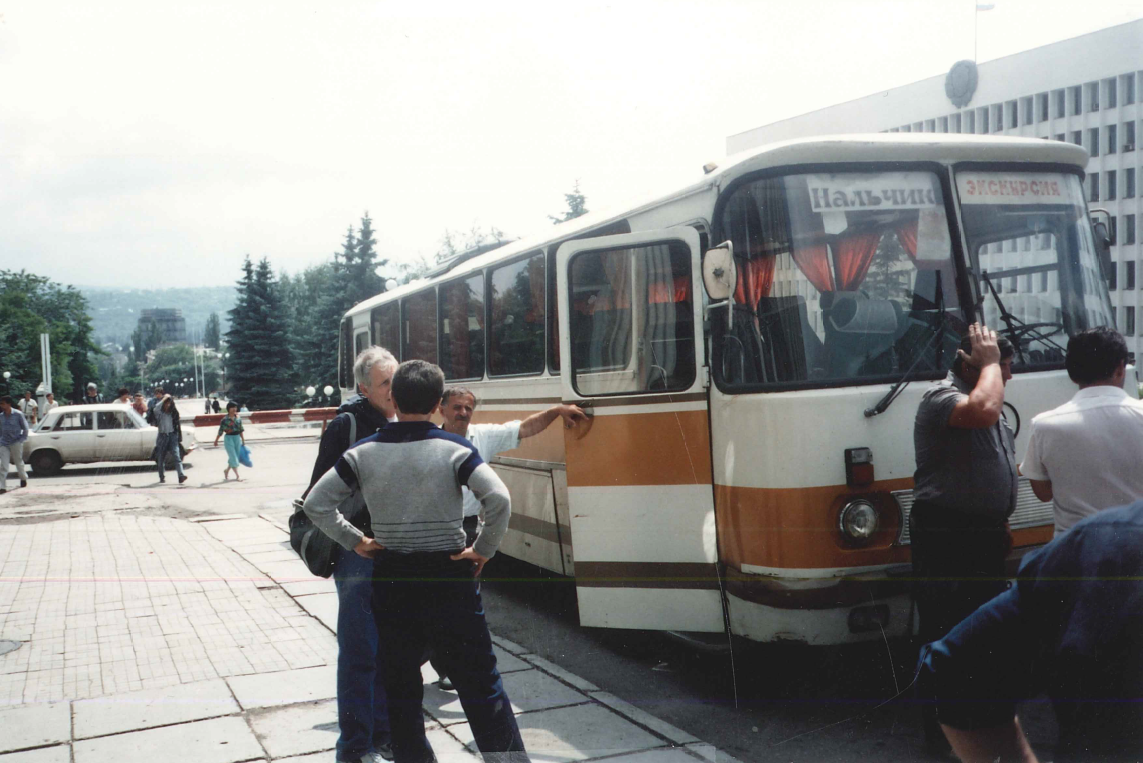
On the morning of the first stage, we had breakfast and then took a bus to the start line. The 42K course was on a paved road, and fairly flat, with a net gain of 300m. The race started at noon. It was raining at the start line, and it continued to rain the whole way. I won the stage, maybe because most of the participants were climbers, rather than runners. A few of us finished well ahead of the rest, and we cheered for the rest of the group as they finished. When the last runner finished, we took the bus back to the lodge in Terskol. We took saunas and had Russian massages. Another surreal experience: hanging out with sweaty, naked men and being whipped with tree branches. At supper, the race director announced the results of the day’s race.
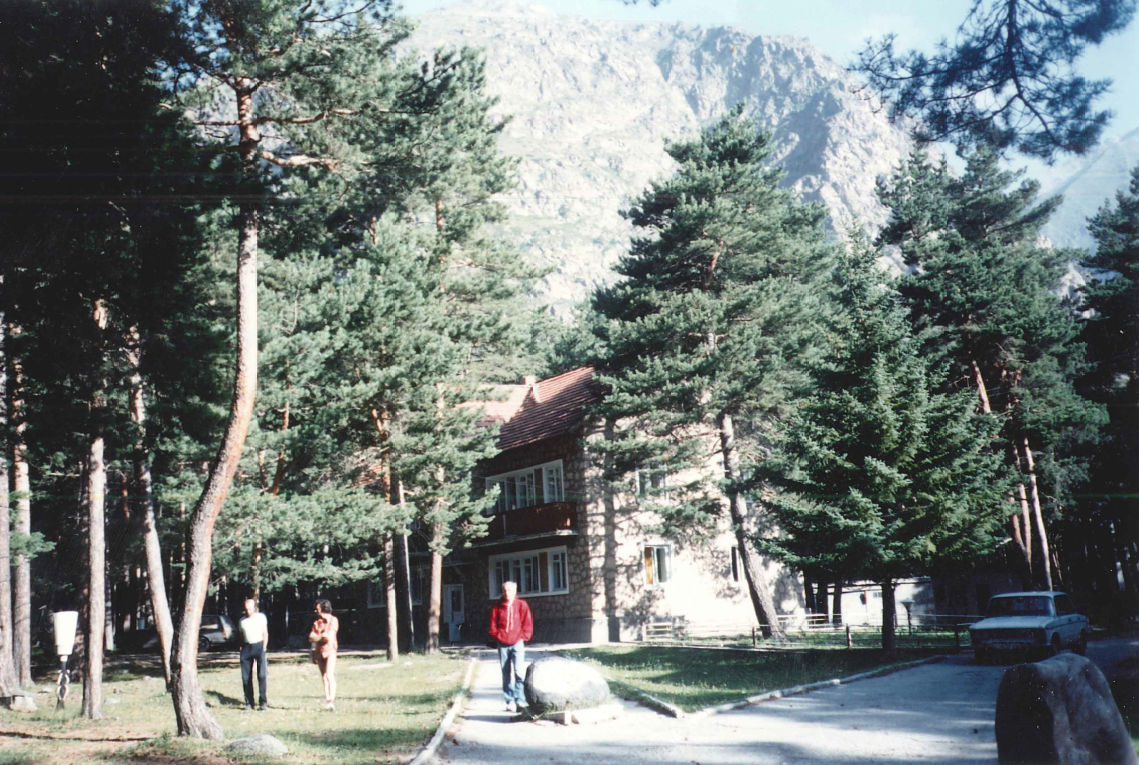
The next day, the rain was gone, and the weather was good, but I felt a little sick, and was having some digestive issues. The race started at noon. The course was a 23K with a 700m net gain, on pavement. It started at the previous day’s finish, and ended at a ski resort. I was second. After lunch we stopped at a mineral water plant and went back to the lodge, where I had another massage. This time it was with the race’s doctor, and it was a much better experience. At supper, when the race results were announced, I learned that my second place finish was close enough to the winner to keep me in position as the overall race leader.
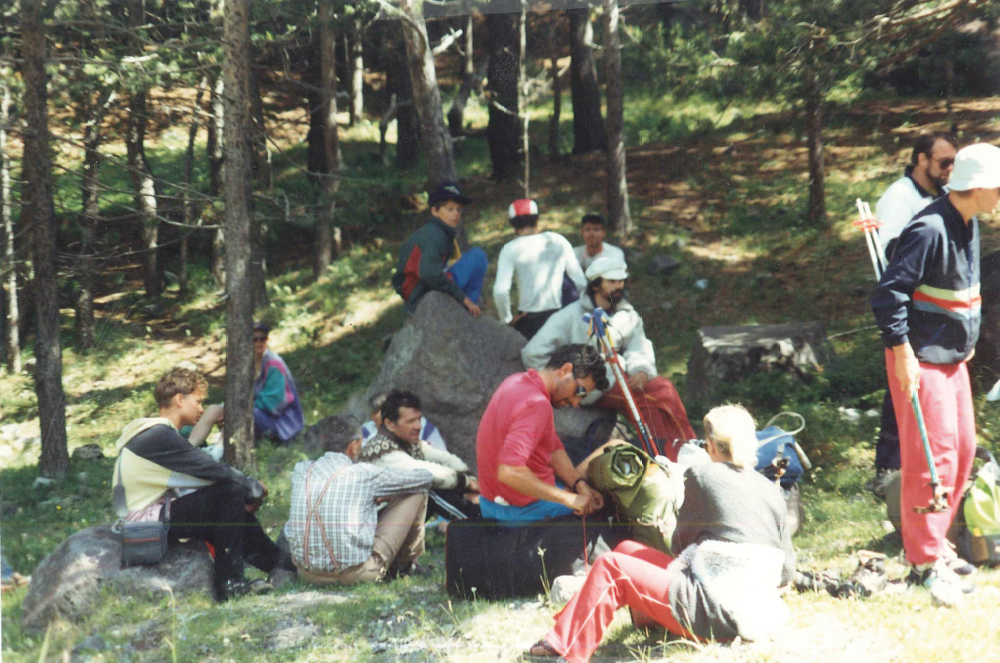

The day of the third stage, I still wasn’t feeling 100%. After breakfast, we packed our bags, because we were moving up the mountain to Priyut II, our next lodging, at 4100m. I called it “Camp Tin Cans” because the cabins looked like red and white cans lying on their sides. We went to the start with our bags and a tram took them to Priyut II for us while we went back to the lodge for lunch. The race started at 3 PM. The course was a 15K with a 1750m climb on a dirt road, starting at the previous day’s finish, and ending at Priyut II.
The camp at Priyut II was another thing about this trip that was unique. I’ve never (before or since) stayed in a camp with round tube-shaped cabins made of metal. It was another out of a movie moment. A unique thing about the camp was the outside toilets. They were a plywood box, almost hanging off the side of a cliff. They weren’t attended too very well, and they were pretty dirty and disgusting.
When the race started, my stomach was really hurting, and I fell back to last place. Midway through the race, I started to feel better, and stronger. I made a big push, and picked up the pace. I made up a lot of time, and was able to finish fourth. After 3 consecutive days of racing, I was second overall, and a few minutes behind the leader. With the next day scheduled as a rest day, I felt confident that I could make up the time on the last stage.
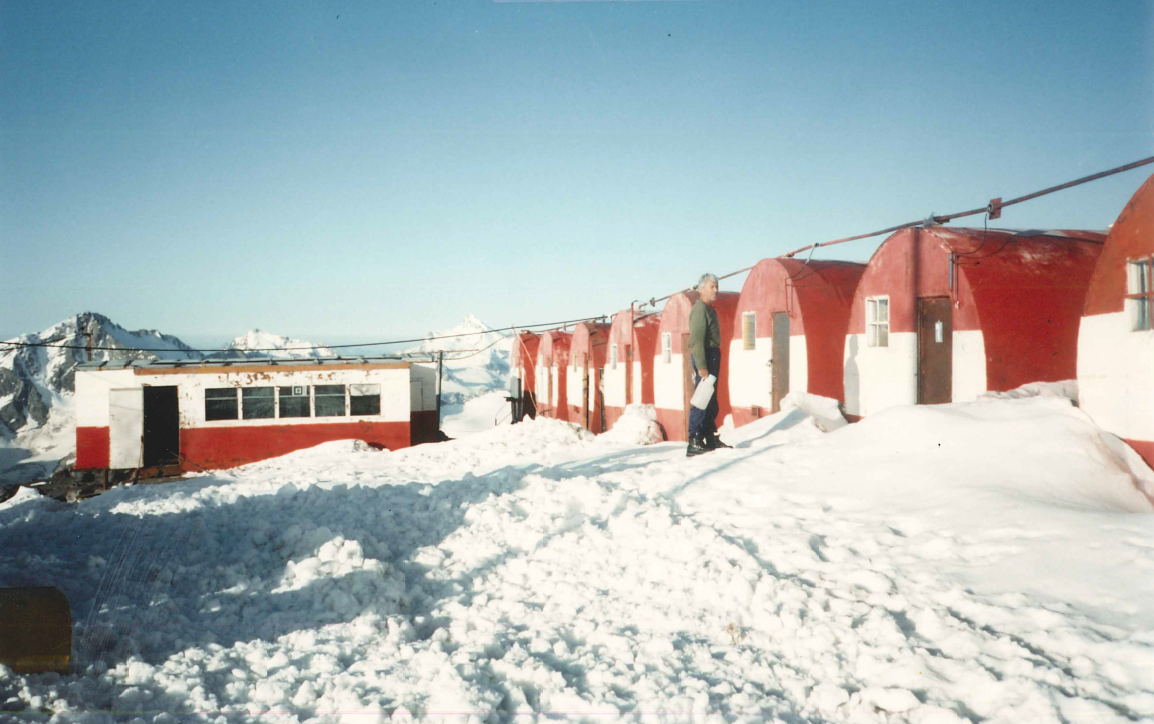
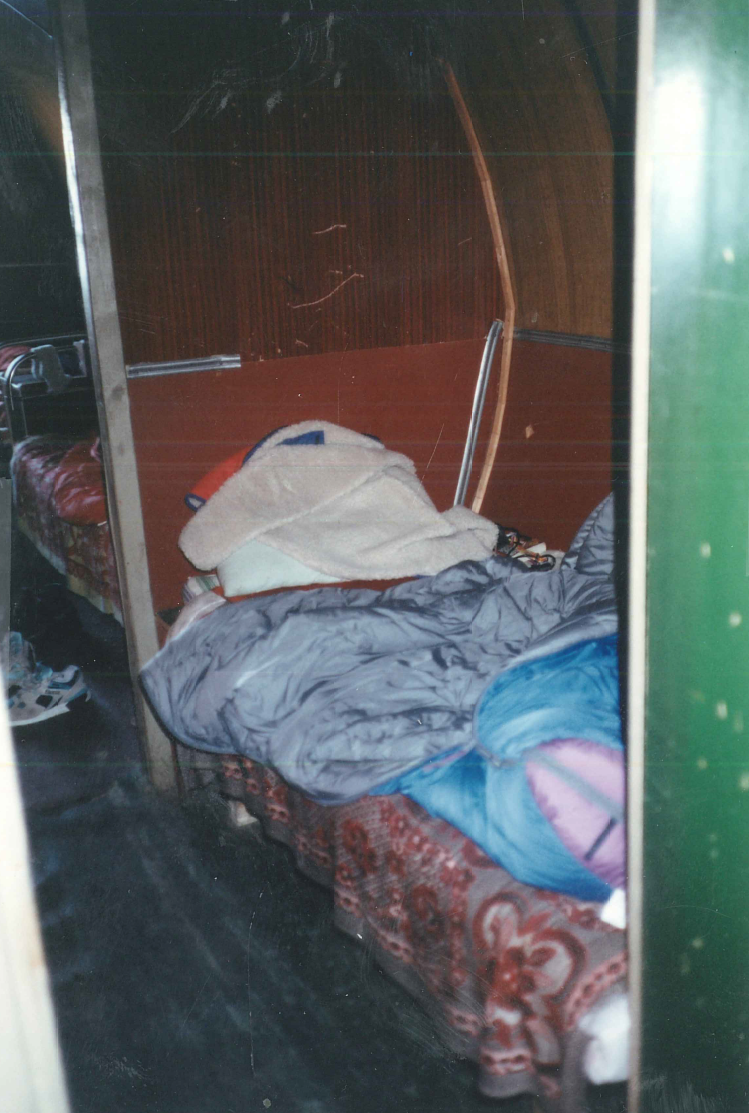
I was excited about climbing to the summit of Elbrus in 2 days. Looking up at the mountain from Priyut II, we could see the two summits: the closer, east summit and the higher, west summit. I asked the race director what route we were taking to the summit. This was the exact moment when I learned that the race finished on the top of the east summit, not on the “Top of Europe” which is the west summit. I was shocked, and in total disbelief. I said “The event is called “Run to the Top of Europe, which is the WEST summit.” He replied “What’s a few meters?” and shrugged. I was still stunned. This whole time (since March) I thought I was going to the Top of Europe, the west summit of Mt. Elbrus. I said, “Well, I’ll climb the west summit instead.” He said “No, Too far. Not possible.” I said “OK and walked away, but I had already decided what I was doing the next day, and it wasn’t resting.

The next morning, I got up early and at 7:15, while everyone else was still asleep, I left the camp. I headed toward the saddle between the east and west summits. Within the first hour, I came across an old wooden hut, Priyut I. It looked like Noah’s Ark, stuck up on the mountain. It was a straightforward climb to the west summit. It took a little less than 6 hours, with an elevation gain of 1542m. I was the only person on the mountain above 4500m. It was awesome. On the summit, I saw the rock where a bust of Lenin had once been, but the bust itself was gone.
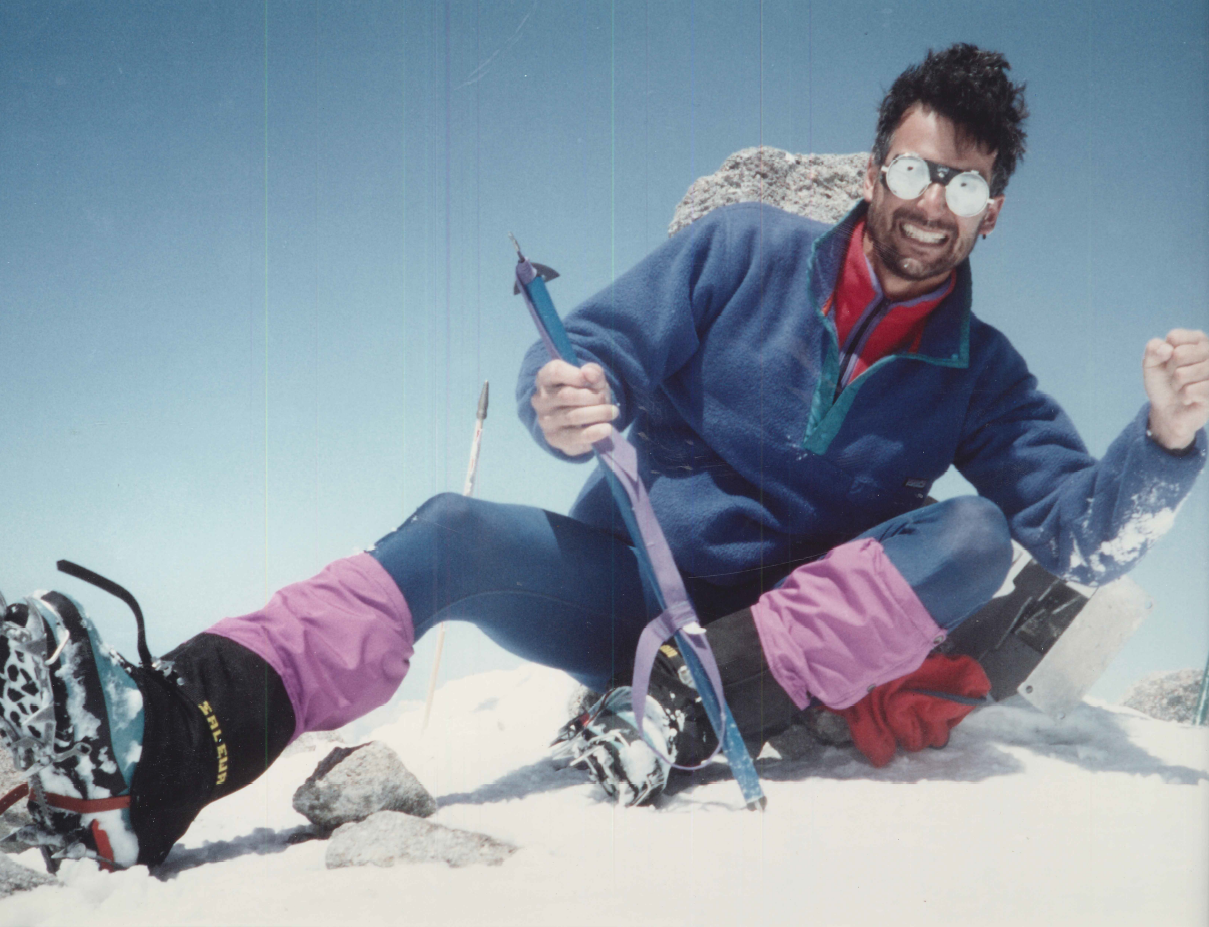
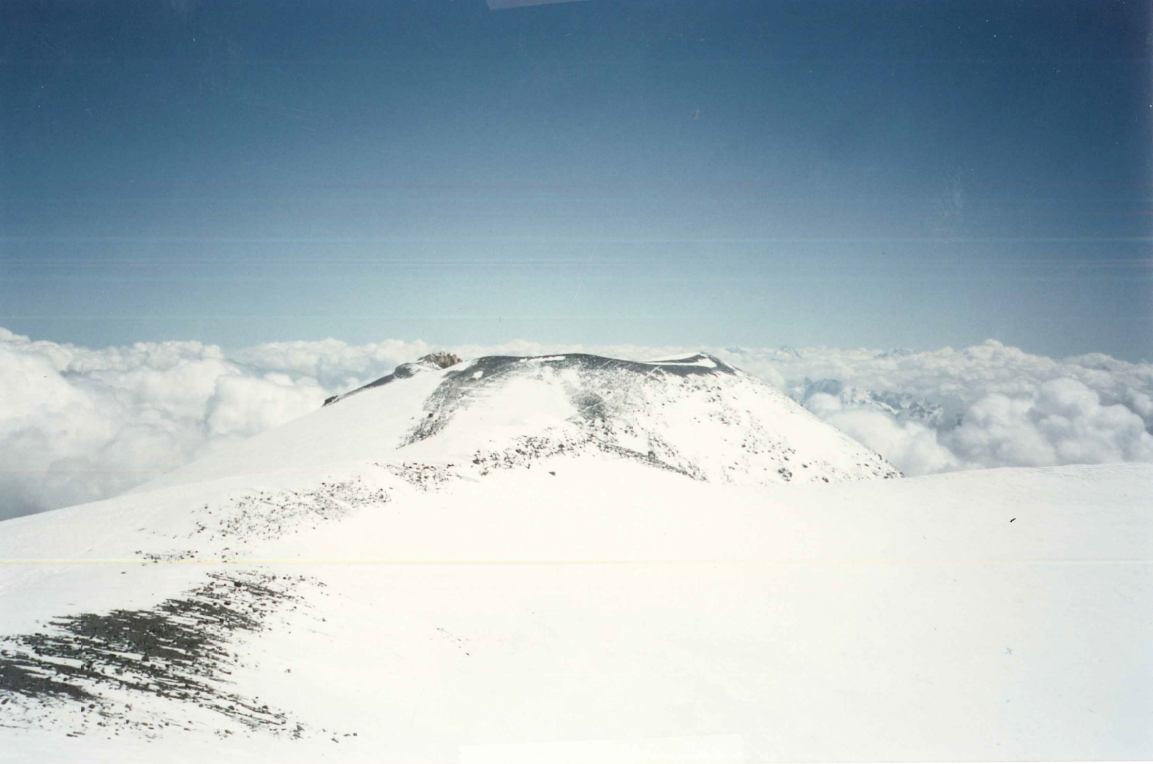
While I was on the summit, clouds started to roll in. I spent 15-20 minutes on top, and then started my descent. When I got to the saddle, I could see Priyut II and the red and white tin cans. Then I found myself in the clouds, with visibility limited to 10 yards. Walking in the clouds, I started to fall into a slow, sinking crevasse. I spread my legs wide, and my crampons caught both sides. It was 3-4 feet wide, and there was a black chasm between my legs. I couldn’t see the bottom of it. I used my ice axe to swing over to one side and climb out. I just sat there waiting for the clouds to clear. It took a while, and when they finally did, I realized that I couldn’t see the tins cans anywhere. I thought I had moved too far to the left, so I walked about 100m to the right, and I could see Priyut II again. I headed straight for it, and was back in camp at 5 PM. I wasn’t sure what kind of reception to expect. To my surprise, I discovered that everyone at camp had been watching my climb through a telescope until the clouds closed in. Everyone congratulated me, and there were no issues. Phew!
I was very tired after 4 straight days of all-out exertion, but I was also really happy, that kind of happy that comes from pushing your body hard and knowing that you’ve answered the challenge. I decided to drop out of the next day’s final stage of the race. I was toast. I was completely exhausted, and I truly felt that I had gotten what I had come for; I had stood on the Top of Europe. Finishing the race didn’t seem as important anymore. The race director was shocked that I wasn’t going to finish the race, since I was potentially a contender to win the whole thing. His lack of comprehension regarding my decision not to finish the race was equal to my lack of comprehension on the previous day, when I had been told that we weren’t actually racing to the Top of Europe. He tried really hard to talk me into it, but my mind was made up.
The next day, the race started at 4 AM, so when I got up, it was already in progress. After breakfast, I hung out at camp and watched the race. When the last person finished, at about 2 PM, everyone hurried to make the last tram down, at 3, to catch the bus back to the lodge at Terskol.
The tram was packed full, so I decided to run down the stage 3 course. I flew down, and arrived at the same time as the tram. We waited for more than an hour for our bus. When we finally arrived at the lodge, we had a big celebration and awards dinner, which meant drinking a lot of alcohol. We started with cases of wine, and when they were gone, they brought out the cases of vodka. No mixers, just vodka. They gave me a special certificate and said, “Fred, who has had freedom his whole life, and we here in Russia, for only a few months.” While they were giving me my award, celebrating my ability to exercise free will, they also mentioned that I was the only participant not to finish, to which I relied that I was the only participant who truly went to the Top of Europe. It was all in good fun, and one hell of a party. It was another once in a lifetime event.
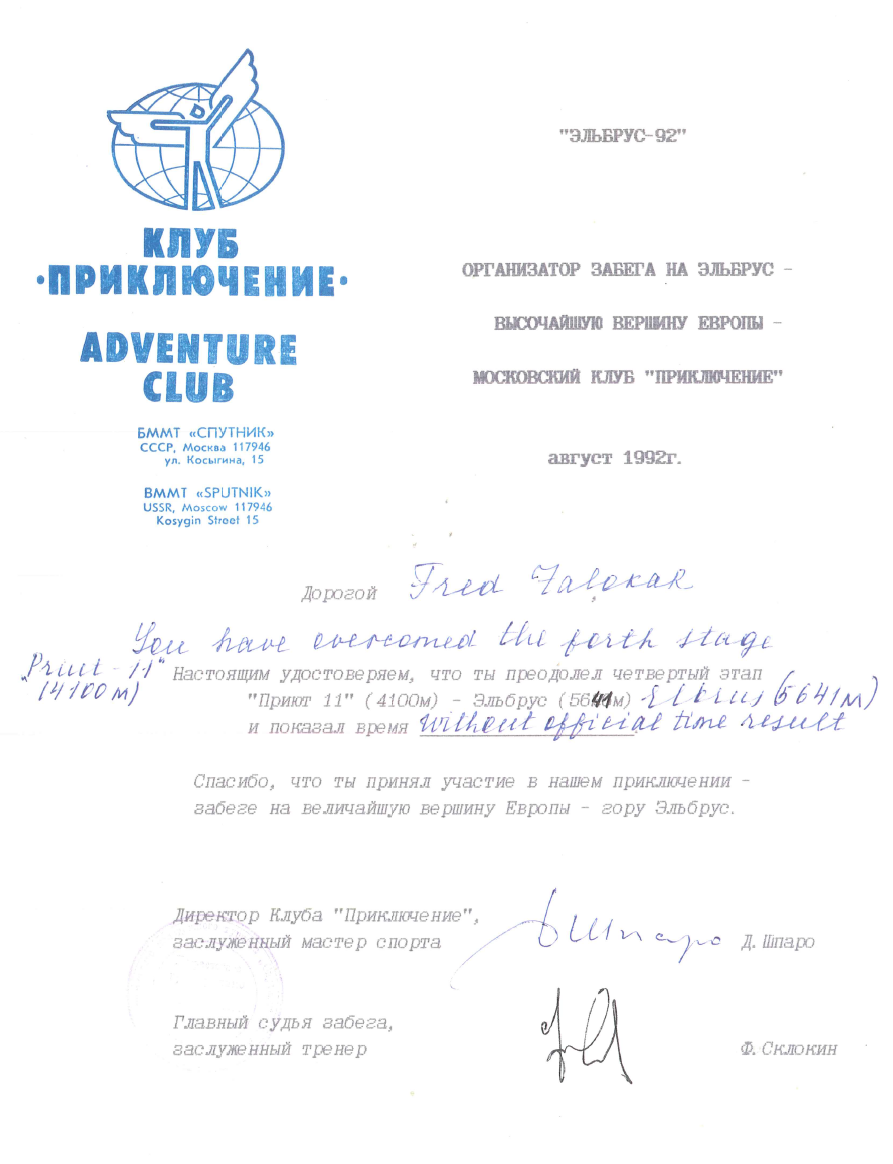
The next day we woke up late, nursed our hangovers at breakfast and packed up our gear. We were going sightseeing in Prielbrusye National Park. We spent a few hours in a river gorge, soaking in the river and doing some bouldering. Then we headed to Nalchik. We checked into a hotel downtown where we would be staying for 2 nights. We had supper which was really good, especially in contrast to what we had been eating at the lodge in Terskol and at the camp at Priyut II. The food there had been basic. There were always 2 saucers on the table: one with salt to flavor the food and one with sugar for the tea. I tried not to mix them up. I’ve always said that to be a good climber, you have to have a cast-iron stomach. I ate everything, but there were definitely some challenging meals. There were more once-in-a-lifetime moments. There was a neon orange broth with fish heads floating it in. There was also the night we were served some sort of mystery meat, served with peas, and covered in a thick white paste.
The next day was spent sightseeing in Nalchik. I remember seeing a lot of statues, and one statue of Lenin that had been knocked down and was lying on the ground. My favorite thing was taking the teleferic up the hill and going to the restaurant on the top, with great food and great views. The people we met were all very friendly and nice.
The following day we did a little more sightseeing, going to a local market. After lunch, we packed up and headed to the airport to fly to Moscow. We arrived late in the day, had supper, and then went to the Moscow Circus.
I spent 2 days in Moscow, sightseeing. Thankfully I still had my interpreter with me! We rode the metro, and went to Red Square and to the Kremlin Museums. We tried to see Lenin lying in state, but weren’t able to. Finishing my trip in Moscow after all the time in the mountains was a great way to get a feel for a different aspect of the country.
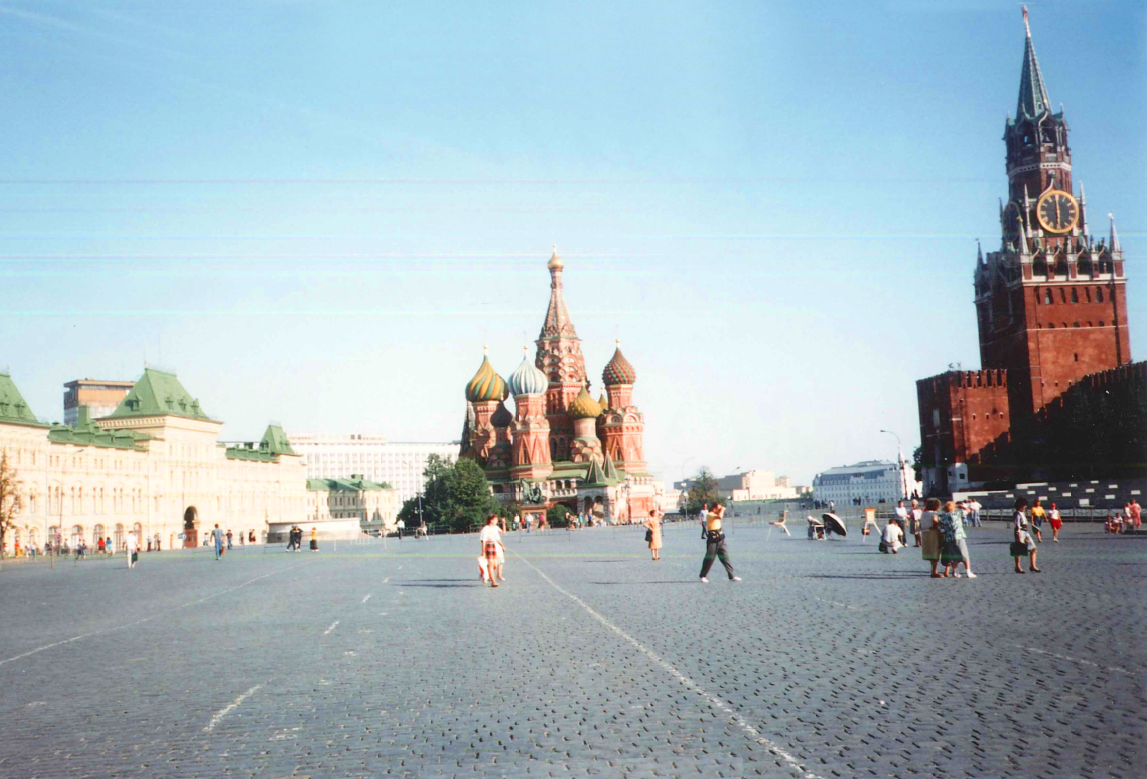
My favorite part of the trip was, of course, summiting Mt. Elbrus, and standing on the Top of Europe. Maybe it was even better because I had to do it on my own. The whole trip was so unique, and so memorable. I consider myself lucky that I was able to be part of a predominately Russian expedition, and that I spent the bulk of my trip in the mountains, running and climbing. The camaraderie between the participants and the fitness challenges we all faced together, were all things that most Americans traveling to Russia would never get to experience. I felt that I was offered a unique look into Russian culture, particularly in 1992. The food, the accommodations and the race itself weren’t designed for tourists, but everyone I encountered was warm and welcoming, and the trip couldn’t have been better.
Dasvidaniya !
